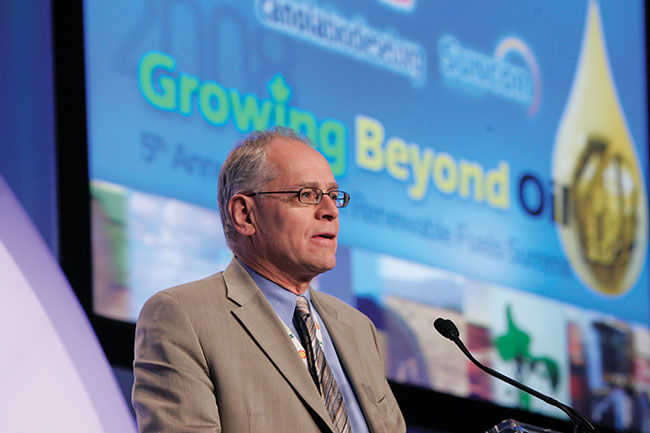
Opinion: The missing bioeconomy link in Canada
August 19, 2022
By Jeff Passmore
Jeff Passmore explains why Canada cannot meet its climate commitments without biomass.
 Jeff Passmore is the founding chair of Scaling Up.
Jeff Passmore is the founding chair of Scaling Up. In its May 2020 report The Bio Revolution: Innovations transforming economies, societies, and our lives, McKinsey Global Institute writes: “The direct economic impact of the Bio Revolution could be up to $4 trillion a year over the next 10 to 20 years. More than half of this direct impact could be in agriculture and food, consumer products and services, and materials and energy production.”
That’s more than $2 trillion per year of products and materials from the sustainable processing of trees, crops (residue or dedicated), grasses, and algae.
Just about everything we consume that comes from a barrel of oil – from transport fuel to heating and cooling, to personal care products – could instead come from biomass.
How is this happening? McKinsey states: “The current innovation wave in biology has been propelled by breakthroughs in the science itself, together with advances in computing, data analytics, machine learning, artificial intelligence, and biological engineering. Biology is increasingly being used to create novel materials that introduce entirely new capabilities, are biodegradable, and/or produced in a way that emits significantly less carbon.”
To discover these “novel materials” go to the U.S. Department of Agriculture’s Bio-Preferred Program. There you will find over 4,000 items certified as minimum 30 per cent derived from plants and other renewable agricultural, marine and forestry materials. Everything from insulation, paints, plasticizers, and cosmetics, to textiles, inks, fragrances, and fertilizers. These certified products qualify for mandatory federal purchasing. Talk about market pull.
Where does Canada sit in all this opportunity? While there are some 60 countries with national bioeconomy strategies, Canada is not among them. The U.S. has had one since 2012. The UK has one. Germany has one. So does the European Commission. Costa Rica has one; its purpose is “to make the bioeconomy one of the pillars for the productive transformation of Costa Rica, by promoting innovation, value addition, diversification and sophistication of [our] economy, applying the principles of the ‘circular bioeconomy’ and seeking the decarbonization of production and consumption processes.” Canada should be embarrassed.
In the U.S., Secretary of Agriculture Tom Vilsack has said, “Why not a bio-based economy that makes the U.S. the envy of the world? It will create jobs and expand our exports.” And the European Commission committed 9 billion euros from 2021 to 2027 to boost research and innovation in sectors covered by the bioeconomy.
The question for Canada then is, do we have the will to be part of this bio-revolution? We certainly have the resources. With 348 million hectares of forests (nine per cent of the world total), 60 million hectares of agriculture land (most in Saskatchewan and Alberta), and dozens of cities wondering what to do with their growing municipal waste, there is no question Canada could be a world leader in the bio-based economy.
To be fair, there are already some Canadian enterprises working in this space including bio-based plastics and cleaning products, renewable fuels, and tall wood buildings. But many have had to go offshore to pursue financing and commercialization.
The 2020 update to the 2016 Pan-Canadian Framework on Clean Growth and Climate Change suggests Canada will “examine options to enhance fuel switching to low-carbon fuels,” and create “new natural resources jobs supporting tree planting and forest management activities,” but this is hardly a strategy or pathway to a bio-based economy.
Canada needs a national bioeconomy strategy led jointly by Agriculture Canada, Natural Resources Canada, and Innovation, Science & Economic Development.
And because money goes where it can find the highest rate of return, the federal government needs to provide capital markets with the right signals to catalyze bio-based investment. As a minimum, it needs to implement a federal bioproducts procurement policy similar to the American Bio-Preferred Program.
Canada cannot meet its Paris Agreement commitments without renewable fuels, biomaterials, and district energy facilities fuelled by biomass or municipal waste. So why not leverage Canada’s natural resource bounty and position ourselves to capture 10 per cent of this global market? That $200 billion per year would create thousands of high-end jobs and put us on a sustainable path to competing in a low-carbon world.
Reindustrialization and wealth creation opportunities like this don’t come along every decade. Hopefully it is not already too late for Canada to grasp its share of the bio-based marketplace. •
Jeff Passmore is the founding chair of Scaling Up, Canada’s annual industrial bioeconomy business conference to be held Nov 7-9, 2022 at the Chateau Laurier Hotel in Ottawa. www.scalingupconference.ca.
This article is part of Biofuels Week 2023. To read more articles on biofuels, click here.
Print this page